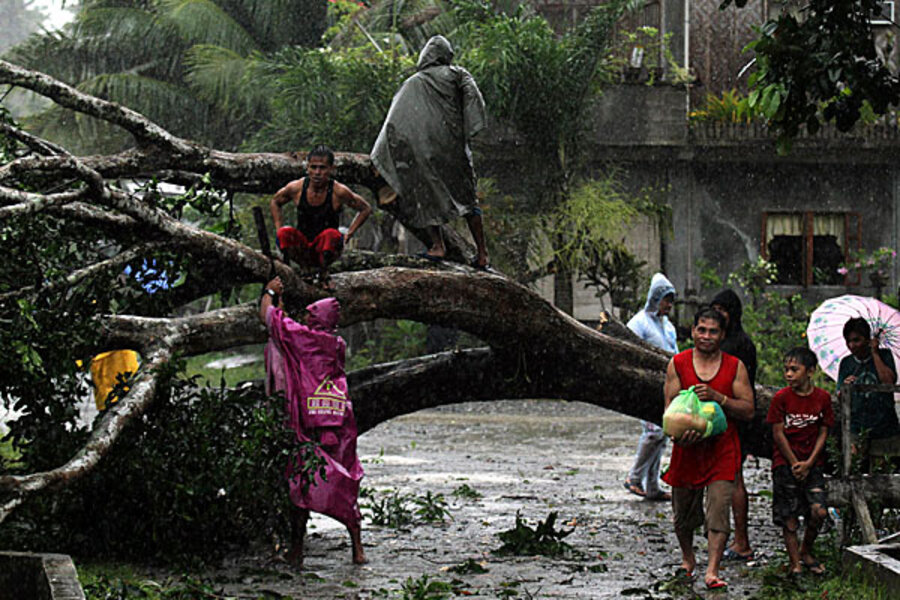Typhoon Bopha hammers Philippines, leaving at least 40 fatalities
Loading...
| Manila, Philippines
One of the strongest typhoons to hit the Philippines this year barreled across the country's south on Tuesday, killing 40 people and forcing more than 50,000 to flee from inundated villages.
Typhoon Bopha slammed into the Davao region at dawn, its ferocious winds ripping roofs from homes and its 500-kilometer- (311-mile-) wide rain band flooding low-lying farmland. The storm, packing winds of 160 kilometers (99 miles) per hour and gusts of up to 195 kph (121 mph), toppled trees, triggered landslides and sent flash floods surging across the region's mountains and valleys.
A Philippine governor says at least 33 villagers and soldiers drowned when torrents of water dumped by a powerful typhoon rushed down a mountain, engulfing the victims and bringing the current death toll from the storm to about 40.
Gov. Arturo Uy says rain from Typhoon Bopha accumulated atop a mountain and then burst down on Andap village in New Bataan town in Compostela Valley early Tuesday. Uy says the victims included villagers who had fled from their homes to a village hall, which was swamped by the flash flood. An army truck carrying soldiers and villagers also was washed away.
In the gold-mining province of Compostela Valley, the fierce wind and rain forced a wall of mud and boulders to cascade down on a house, killing three children.
"The only thing we could do was to save ourselves. It was too late for us to rescue them," said Valentin Pabilana, who survived the landslide.
A soldier died and 20 villagers were missing after a flash flood raced down a mountain in Andap town, washing away a truck, according to Compostela Valley Governor Arturo Uy and military officials.
In nearby Davao Oriental, a poor agricultural and gold-mining province about 1,000 kilometers (620 miles) southeast of Manila, an elderly woman was killed when her house was struck by a tree felled by howling wind, said Benito Ramos, an ex-army general who now heads the government's disaster-response agency.
He said the death toll was expected to rise once soldiers and police gain access to some far-flung villages isolated by floods, fallen trees and downed communications.
Regional disaster-response officer Liza Maso told The Associated Press by telephone that she was trying to confirm an army report that a flash flood washed away a truck carrying an undetermined number of people in New Bataan town, also in Compostela Valley.
While some 20 typhoons and storms normally lash the archipelago nation annually, the southern provinces being battered by Bopha are unaccustomed to fierce typhoons. A rare storm that took the area by surprise last December killed more than 1,200 people and left many more homeless and traumatized.
Officials were taking no chances this year, and President Benigno Aquino III made an appeal on national TV Monday for people in Bopha's path to move to safety and take storm warnings seriously.
"This typhoon is not a joke," Aquino said after meeting top officials in charge of disaster-response.
"But we can minimize the damage and loss of lives if we help each other," he added.
Aquino outlined preparations, including evacuations and the deployment of Army search and rescue boats in advance. Authorities also ordered small boats and ferries not to venture out along the country's eastern seaboard, warning of rough seas with up to 4-meter (13-foot) waves.
In Compostela Valley, authorities halted mining operations and ordered villagers to evacuate to prevent a repeat of deadly losses from landslides and the collapse of mine tunnels seen in previous storms.
Bopha, a Cambodian word for flower or a girl, is the 16th weather disturbance to hit the Philippines this year. Forecasters say at least one more storm may hit the country before Christmas.
___
Associated Press writer Teresa Cerojano contributed to this report.
Copyright 2012 The Associated Press.







